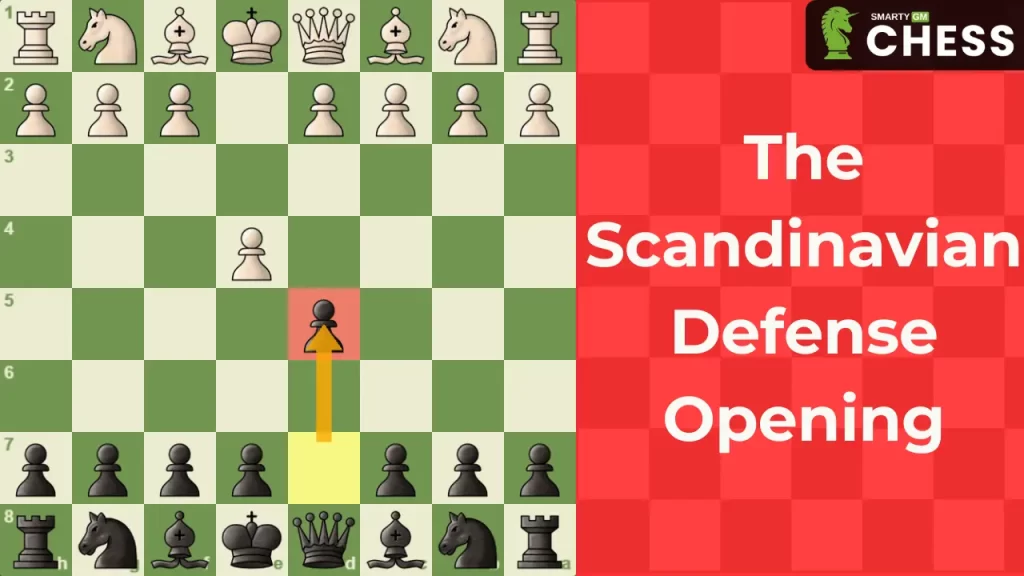Are you looking for an effective and dynamic response to White’s 1.e4 in chess?
The Scandinavian Defense opening is a dynamic and counterattacking response to 1.e4, one of White’s most common opening moves in chess.
In this defense, Black immediately challenges White’s central pawn by playing 1…d5, aiming to disrupt White’s pawn structure and seize control of the center.
In this article, we delve into the intricacies of The Scandinavian Defense Opening, exploring its history, key concepts, variations, and enduring impact on modern chess strategy.
Read also: The London System Opening: Basics, Middlegame, and Traps
The Scandinavian Defense is a chess opening that puts you, as Black, in an immediate counterattacking position against White’s 1.e4 by responding with 1…d5
When you play 1…d5, you’re directly challenging White’s central pawn, disrupting their pawn structure, and aiming to control the center early on.
If we look at history, this opening is not attributed to a single inventor but has evolved through various players’ contributions and games.
Playing the Scandinavian Defense requires you to be prepared for various responses from White, and your goal is to equalize and seize the initiative by pressure White’s position right from the start.
This makes the Scandinavian Defense a favorite among players looking for a dynamic and aggressive opening choice.
The first move is Pawn to e4, and if you’re an e4 player, you need to know how to handle the Scandinavian.
So, what’s the point of playing Pawn to d5?
The fundamental idea about the opening is to develop your pieces and fight for the center, and d5 helps you achieve both goals.
You do fight for the center, and you occupy c4, and on top of that, you open up this diagonal for your bishop and this line for your queen:
When the white player takes the pawn on d5, you can recapture with the Queen:
Then, he plays Nc3 most of the time, and that’s the main line of The Scandinavian Defense Opening.
After 1…d5 2.exd5, Black typically plays 2…Qxd5. This variation leads to a symmetrical pawn structure but allows Black to develop quickly and maintain pressure on White’s center.
When your opponent plays Nc3, you move your Queen to a5, and then you play pawn to c6 to prevent your Queen from getting stuck.
Now, you have a very good position; you control the center, and you can create an attack on the King by playing Bd6 or Nd5, and you have a solid position.
The exd5 Nf6 Variation
In this Variation, you don’t take the d5 Pawn with the Queen, instead, you play Nf6.
If our opponent plays c4, you can play e6 and exchange the pawn. After some moves, you can pin the Knight with Be4.
So, your plan is very simple, you’re gonna castle and you can see that you put so much pressure on white along the d-file with your Rook along the e-file with the Queen.
The Queen is also hitting the g2 Pawn, and your Bishop is also hitting c4.
You have so many threats that make whites weak and defenseless.
Advantages
- Early Counterplay
- Develop pieces quickly
- Unbalancing the Game
- Surprise Factor
weaknesses
- Potential Weakness on d5
Read also: The Englund Gambit Opening Explain
There are so many traps and tricks you can use it in this opening, especially for the players below 2000 ELO:
if exd5 Qxd5
For Black:
Trap 1 – Win a Bishop
Trap 2 – Win a Bishop #2
For White
Trap 3 – Queen Sacrifice
Trap 4 – Fork the Queen
if exd5 Nf6
For Black:
Trap 1 – Algerian Gambit
Trap 2 – Trap the Queen
For White:
Trap 3 – Chekmate in 13 moves
Trap 4 – The big Attack!
Several famous games have been played using The Scandinavian Defense, showcasing its effectiveness and strategic depth. Here are a few examples:
Garry Kasparov (2851) vs. Viswanathan Anand (2751)
Fabiano Caruana (2844) vs. Magnus Carlsen (2830)
LPSupi (3050) vs. MenuGarden (3078)
Actually, it’s hard to beat this opening, but I can give you some tricks to counter it as a White:
if Black play Qd8
If Black returns his Queen to d8 you can beat him with this trick (sacrifice the your Queen):
if Black play Qa5
First, you play Bishop to c4, then solidify it by playing Pawn to d3. Now, your position is so solid, and everything is well-defended.
Second, you’re preparing to Castle Queenside and plan to play Bishop d2 and Queen to e2.
After some moves, you can trick your opponent and checkmate him or get a very solid position with many tempos over the Dark Bishop.
- The Scandinavian Defense: Move by Move – by Cyrus Lakdawala
- The Scandinavian: The Dynamic 1.e4 Counter” by Daniel Lowinger
- Play the Scandinavian – by Christian Bauer
- Scandinavian Defense: The Dynamic 3…Qd6 – by Michael Melts
- The Scandinavian – by John Emms
Read also: The Scandinavian Defense Explain
Resources
https://www.youtube.com/@GMIgorSmirnov
Frequently asking questions (FAQ)
Yes, the Scandinavian Defense is a good choice for players seeking dynamic counterplay and strategic diversity in their games.
Both the Scandinavian and Sicilian Defenses are strong, but their effectiveness depends on your playing style and the positions you prefer.



2 Comments
Pingback: The London System Opening: Basics, Middlegame, and Traps - Smarty Chess
Pingback: The Danish Gambit Opening: Basics, Middlegame, and Traps - Smarty Chess